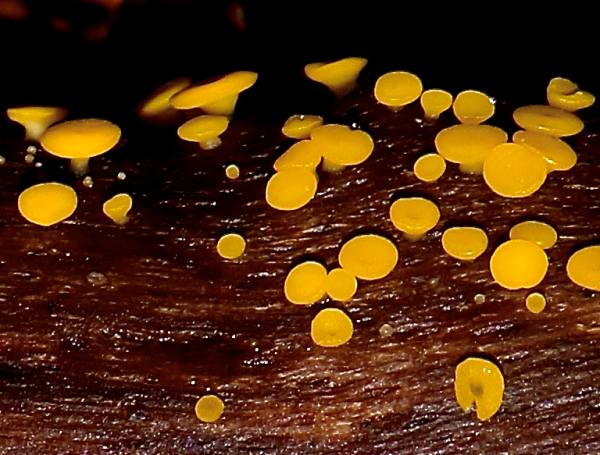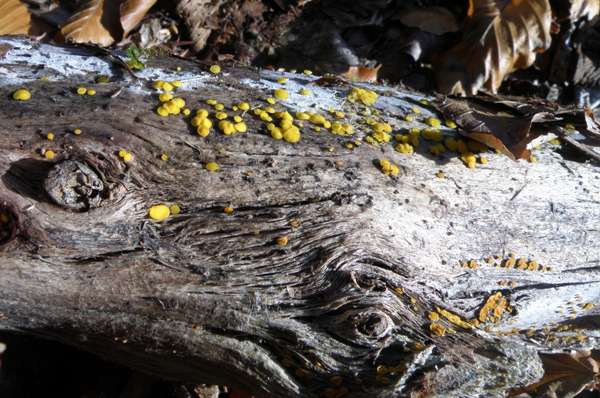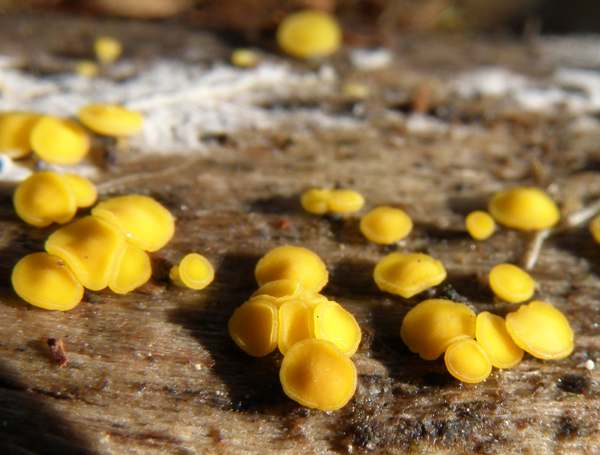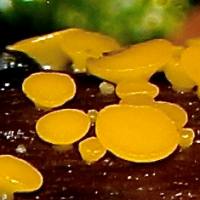Trees Birds Mammals Fish Amphibians Reptiles
Wild Algarve
Bookshop
Bisporella citrina (Batsch) Korf & S.E. Carp. - Lemon Disco
Phylum: Ascomycota - Class: Leotiomycetes - Order: Leotiales - Family: Helotiaceae (insertae sedis)
Distribution - Taxonomic History - Etymology - Identification - Culinary Notes - Reference Sources

This colourful wood-rotting fungus is commonly found on dead oaks and other hardwoods.
Citrin- literally means lemon-yellow, but don't let that mislead you: the fruitbodies are often a bright daffodil yellow.
Tiny it may be, but because of its gregarious nature (the tiny fruitbodies can swarm in hudreds or even thousands on a fallen trunk) the Lemon Disco is not a difficult fungus to spot.

Distribution
Common and widespread in most parts of Britain and Ireland, this wood-rotting ascomycete is found also throughout mainland Europe as well as in many other parts of the world including North America.

Taxonomic history
Described in 1789 by German naturalist August Johann Georg Karl Batsch (1761 - 1802), who gave it the binomial scientific name Peziza citrina, this wood-rotting fungus was transferred to the genus Bisporella by American mycologists Richard P Korf and Steven E Carpenter in 1974, thus establishing the currently-accepted scientific name Bisporella citrina.
Synonyms of Bisporella citrina include Octospora citrina Hedw., Peziza citrina Batsch, Peziza claroflava Grev., Helotium citrinum (Hedw.) Fr., Helotium claroflavum (Grev.) Berk., Helotium flavum Klotzsch, Calycella citrina (Hedw.) Boud., Calycella claroflava (Grev.) Boud., and Calycella flava (Klotzsch ex W. Phillips) Boud.bisporella-citrina4.

Etymology
The specific epithet citrina refers to the lemon-yellow colour of the fruitbodies.
Identification guide

|
Fruitbody
Lemon or bright yellow, paler at margin; flat-topped or saucer-shaped disc with a very short, tapered stem; normally in swarms; gelatinous; individual fruitbodies 1 to 3mm across and 1 to 2mm tall. |
| |
Spores
Ellipsoidal, smooth, 9-14×3-5µm; when fully mature they develop one cross wall (termed becoming septate) and have oil droplets at either end.
Spore print
White. |
Odour/taste |
Not distinctive. |
Habitat & Ecological role |
Saprobic, on rotting trunks and stumps of broadleaf trees, particularly oaks. |
Season |
Fruiting in late summer, autumn and early winter. |
Similar species |
The basidiomycete Dacrymyces stillatus, known as Common Jellyspot, is typically smaller but can sometimes be of comparable size; it is a similar colour but its fruitbodies are usually blob-like rather than cup shaped. |
Culinary Notes
Most ascomycetous cup fungi are considered inedible, and w hether these particular cup fungi are edible is of little consequence because they are far too small to be worth gathering for eating.
Reference Sources
Fascinated by Fungi, 2nd Edition, Pat O'Reilly 2016, reprinted by Coch-y-bonddu Books in 2022.
Dennis, R.W.G. (1981). British Ascomycetes; Lubrecht & Cramer; ISBN: 3768205525.
Breitenbach, J. & Kränzlin, F. (1984). Fungi of Switzerland. Volume 1: Ascomycetes. Verlag Mykologia: Luzern, Switzerland.
Medardi, G. (2006). Ascomiceti d'Italia. Centro Studi Micologici: Trento.
Donadini J.C. 1981. Le genre Peziza dans le sud-est de la France, avec clef du genre pour la France; Universite d'Aix-Marseille
Dictionary of the Fungi; Paul M. Kirk, Paul F. Cannon, David W. Minter and J. A. Stalpers; CABI, 2008
Taxonomic history and synonym information on these pages is drawn from many sources but in particular from the British Mycological Society's GB Checklist of Fungi.
Acknowledgements
This page includes pictures kindly contributed by James Wainscoat.
Top of page...
Fascinated by Fungi. Back by popular demand, Pat O'Reilly's best-selling 450-page hardback book is available now. The latest second edition was republished with a sparkling new cover design in September 2022 by Coch-y-Bonddu Books. Full details and copies are available from the publisher's online bookshop...